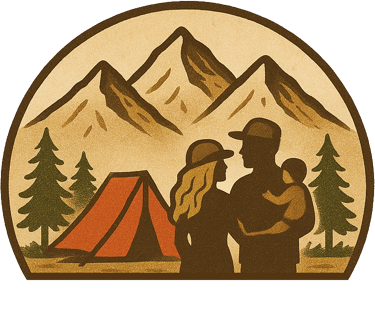Kalalau Trail: A Once-in-a-Lifetime Journey into the Heart of Kauai
BACKPACKING
Petra and Jan
7/10/202510 min read
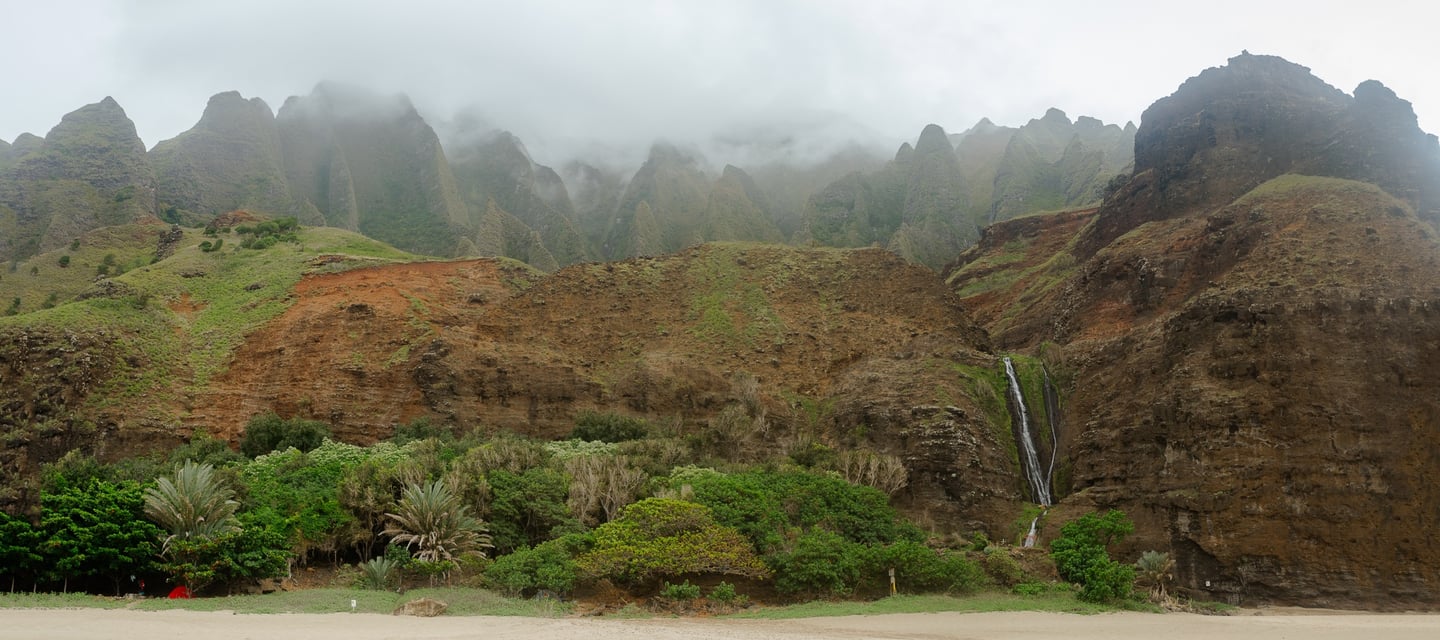

Some places you visit. Others change you. The Kalalau Trail, carved into the emerald cliffs of Kauai’s legendary Nā Pali Coast, belongs to the latter.
This 35 km (22-mile) round-trip journey, often called one of the most beautiful—and dangerous—hikes on earth, is the crown jewel of Hawaiian wilderness. Imagine stepping into a living painting: razor-sharp cliffs plunging into turquoise Pacific waters, waterfalls cascading through ancient valleys, and beaches so remote they can only be reached on foot.
But beauty often walks hand-in-hand with peril. The Kalalau Trail has claimed lives—too many to ignore—and consistently ranks among the world’s most dangerous hikes. Steep drops, flash floods, and treacherous footing make it a serious challenge even for experienced hikers.
The Dream Begins… Online
Before you even lace up your boots, your Kalalau journey starts online. Permits are required if you plan to hike beyond Hanakāpī‘ai Valley (about 3.2 km in) or to camp at either Hanakoa or Kalalau Beach (Same permit). Permits are $35 per-person per-day. These permits are limited (60 per day) to protect the sacred land and to avoid overcrowding. If you’re caught without one, expect a fine of $500 or more—but honestly, it’s more about respecting the local culture and environment.
The permit system opens 90 days in advance at midnight Hawaiian time and sells out within minutes. You will first need to create an account at the official State of Hawaii website and we recommend doing this before the permit system opens at least a couple days ahead.
At 3am BC time, we logged in and we hit refresh like crazy and grabbed the last spots. Our entire trip ended up being planned around these dates.
We booked direct flights from Vancouver to Kauai, which made logistics easier.
Polynesia Hiking vs. Pacific Northwest: A Different Beast
Coming from British Columbia, we thought we knew hiking. But Kauai plays by its own rules.
Forget bears and snow (yes, you can leave the bear spray at home!). Here, the real dangers are heat, dehydration, flash floods, and cliffs that drop straight into the sea . Weather shifts in an instant: you can have sunshine, pounding rain, and gale winds all in one afternoon. Here, even waterproof boots can fill up like buckets. And when it rains—it really rains. Tropical downpours turn rivers into raging torrents in minutes.
Logistics: Before You Step on the Trail
Give yourself at least a buffer day before and after your hike—because getting stuck due to weather is not just possible, it’s common. Cars at the trailhead (Hāʻena State Park) have been frequent targets for break-ins and gas theft, so it’s wiser to arrange a drop-off.
The Kalalau Trail itself is:
22 miles (35 km) round trip
~2,000 meters cumulative elevation gain
Generally done over 2–5 days
Key points: Hanakāpī‘ai Beach (2 miles/3.2 km) - no permits required until this point or even until the waterfalls further up the valley, Hanakoa Camp (6 miles/9.7 km), Kalalau Beach (11 miles/17.7 km one-way)
Essential Gear: Polynesia-Style Packing
What you need here is not your standard BC kit. Leave the bear spray at home. Instead, focus on:
Footwear: The eternal debate: Heavy boots? Good support but terrible when wet. Sandals? Great for river crossings but no good with a heavy pack. We ended up using both.
Water: Streams are plentiful but filter or treat every drop.
Waterproof everything. Dry bags are non-negotiable. Tropical rain is unforgiving.
Minimal clothing: It’s warm—even at night—but a light tent is essential for protection from rain, bugs, and curious goats.
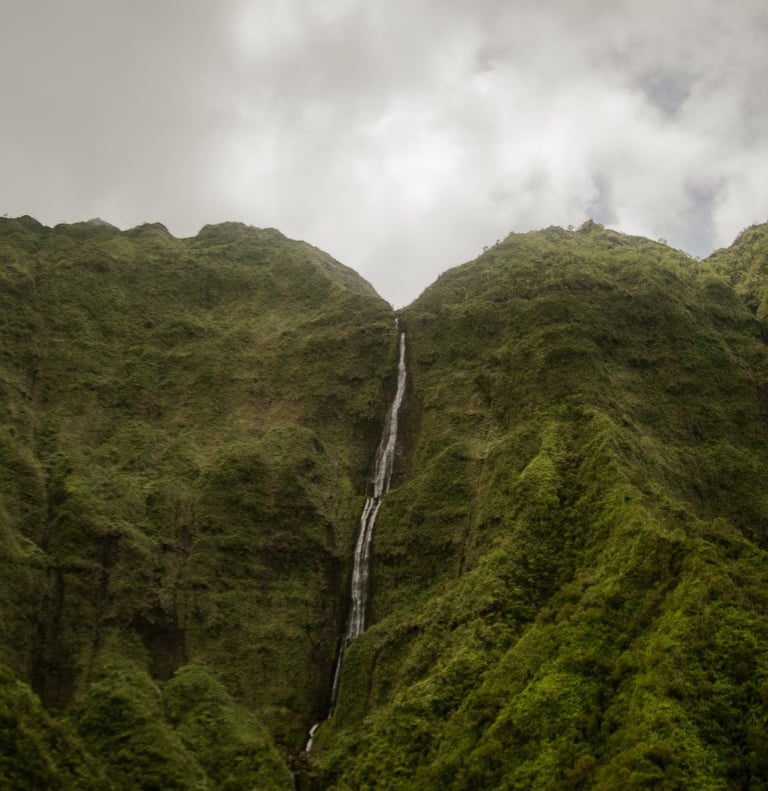


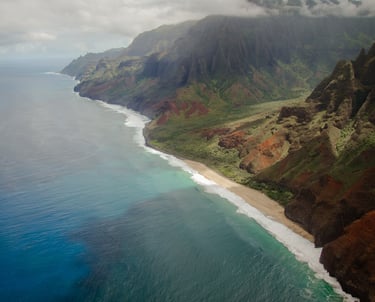
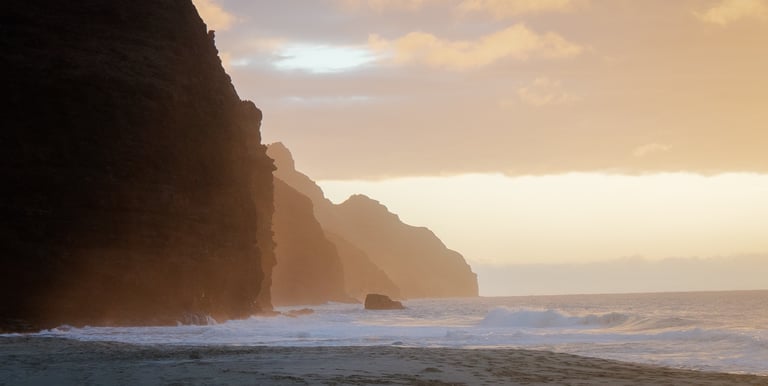

Best time to go
The best time to hike the Kalalau Trail is generally during the drier months, which are May through September.
These months typically offer:
More stable weather
Lower chances of flash floods
Safer river crossings
Longer daylight hours
Avoid going between November to March as this is the peak of the rainy season and it comes with
Frequent storms and heavy rain
High risk of flash floods
Trail closures are more common
Stream crossings like Hanakāpī‘ai can become impassable
If you want ideal conditions, early June or late August often hit the sweet spot—dry but not brutally hot, and slightly less crowded than peak summer.
What to Know Before You Go
The trail features several stream crossings, sparking endless online debates about the best footwear. Sandals make water crossings easier but offer little support for heavy backpacks. On the other hand, waterproof hiking boots provide stability but will eventually get soaked—because when it rains in Kauai, it really rains. The best solution is personal: it's a balance between protection, comfort, and weight. Petra carried both boots and sandals, which proved ideal but added extra weight.
Packing your clothes in waterproof bags is a must—once things get wet, they stay wet. The trail begins at Ke'e Beach and the first 2 km to Hanakāpī‘ai Beach is relatively well maintained with stone steps and a steady elevation gain of about 150 meters. This section is deceptively easy compared to what lies ahead.
The first stream crossing at Hanakāpī‘ai is usually manageable, but taking off your shoes is recommended to avoid blisters from soaked footwear. The stream can become a raging torrent after heavy rain, making crossings dangerous or impossible.
Hanakāpī‘ai waterfall further up the valley is a popular hike for people without overnight permits, but keep in mind, the trail to the falls continues at the other side of the stream, and that stream can rise fast if it starts raining. We've heard of hikers getting stuck on the wrong side with no food, no gear, and no way out until the water drops. If clouds are rolling in or rain starts, don’t wait—turn around and cross back right away.
From here, the trail gets real. You climb, descend, climb again. Every step reveals more of the Nā Pali Coast's dramatic cliffs. Around 5 km in, you reach “The Gate”—the trail opens up and the views punch you in the gut (in the best way).
The vegetation here is lush beyond imagination—dense, vibrant green, alive with the sounds of the island. Water is abundant but must be treated or filtered. Avoid drinking from streams close to the ocean to prevent consuming salty water.
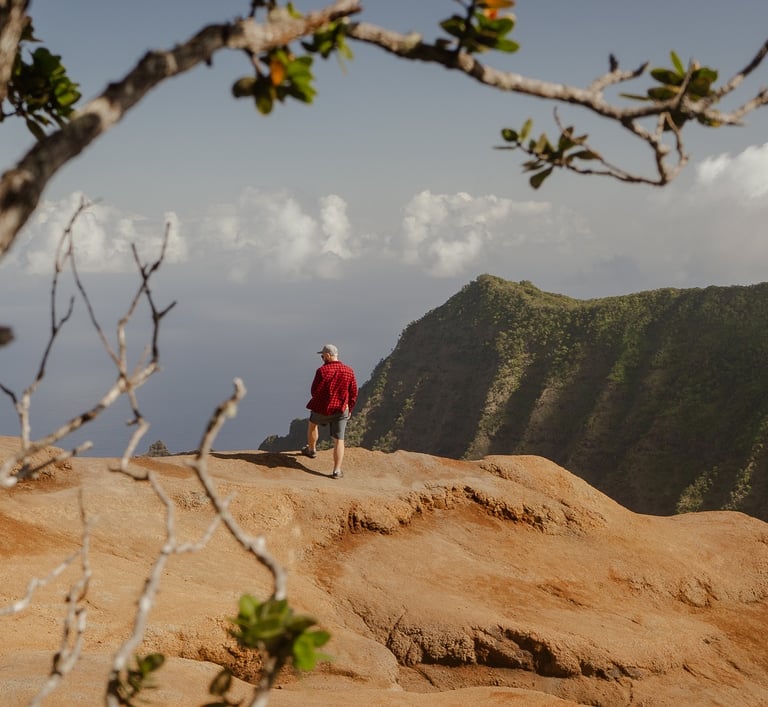

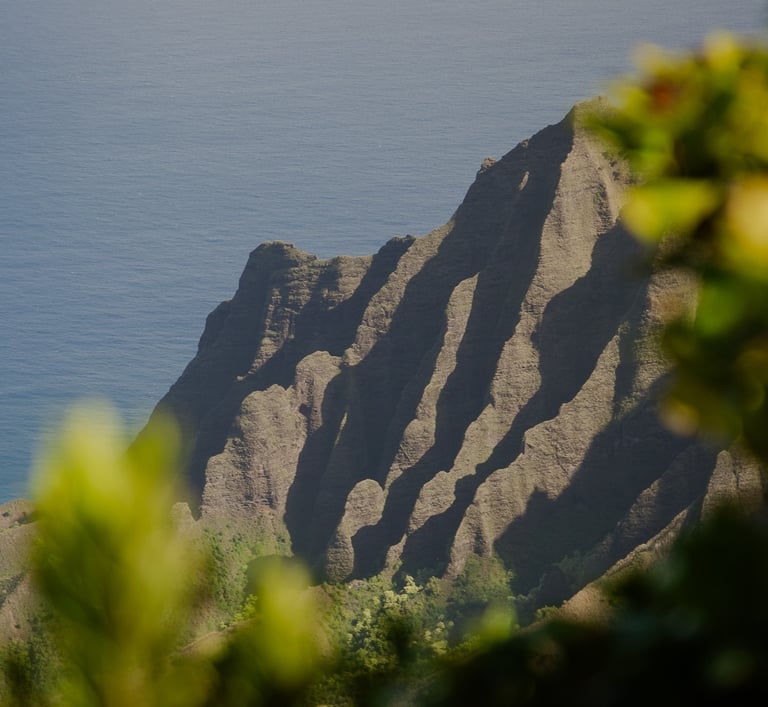

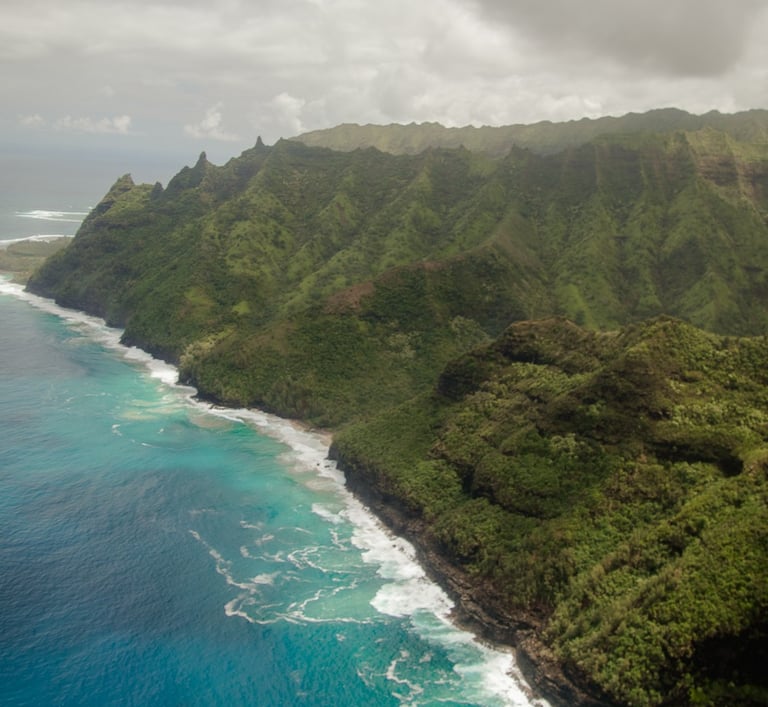

Our Story: The Kalalau Trail in Two Days
We did the hike in two days—not ideal, but that’s what the permit gods allowed. We found a local in a Facebook group who let us stash our extra gear and gave us a ride to the trailhead (life-saver!). Rangers check permits early, so don’t think you can sneak by. We started hiking as early as 5:30 am and would highly recommend doing the same. This early start gave us a quiet trail and pleasantly cool temperatures. Once the sun comes out and hits the lush, wet rainforest, the humidity becomes horrendous.
The first 9 km of the trail were fairly easy, with multiple stream crossings. The biggest one, around the 2 km mark—Hanakāpī‘ai Stream—we crossed in water sandals after taking off our hiking shoes. It was fun and super refreshing. :)
At this point, we were surprised to see a shelter on the other side of the stream. (In case you get cut off on your way back due to a swell, you can spend another night or two in this shelter.)
We also passed an information table with lots of useful details about the trail, along with—unfortunately—a sobering number of warnings about how many lives this trail has claimed.
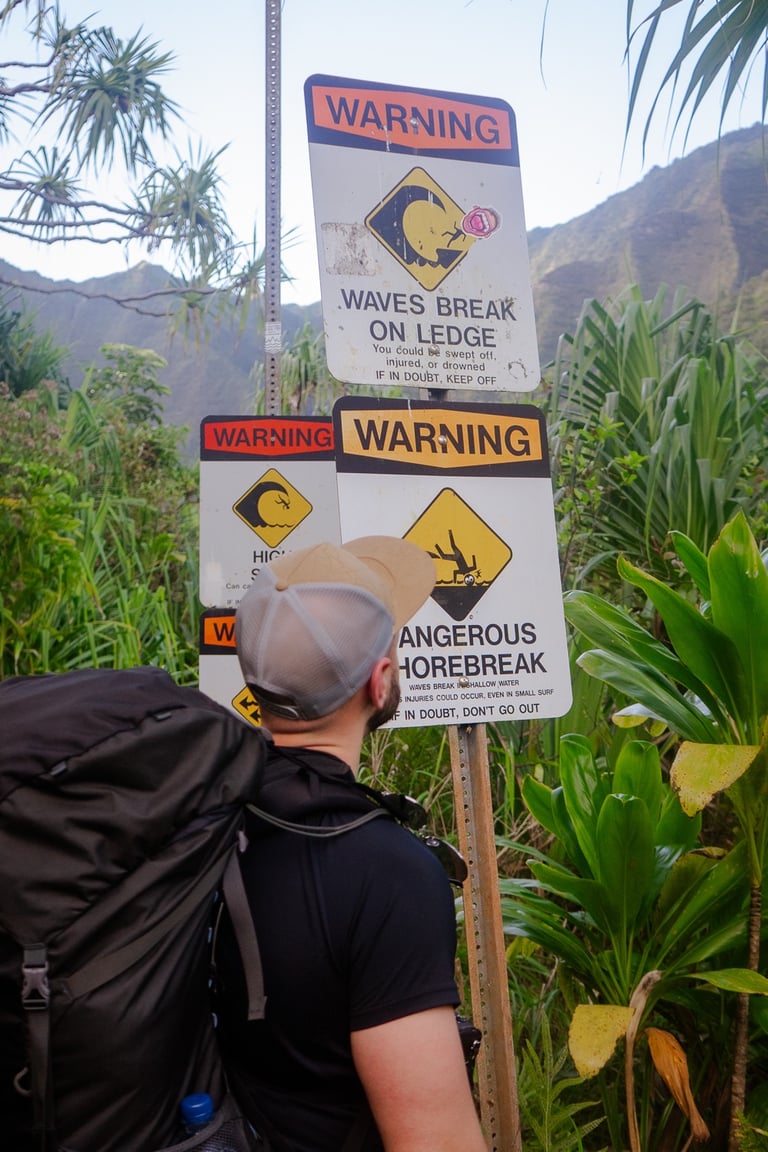
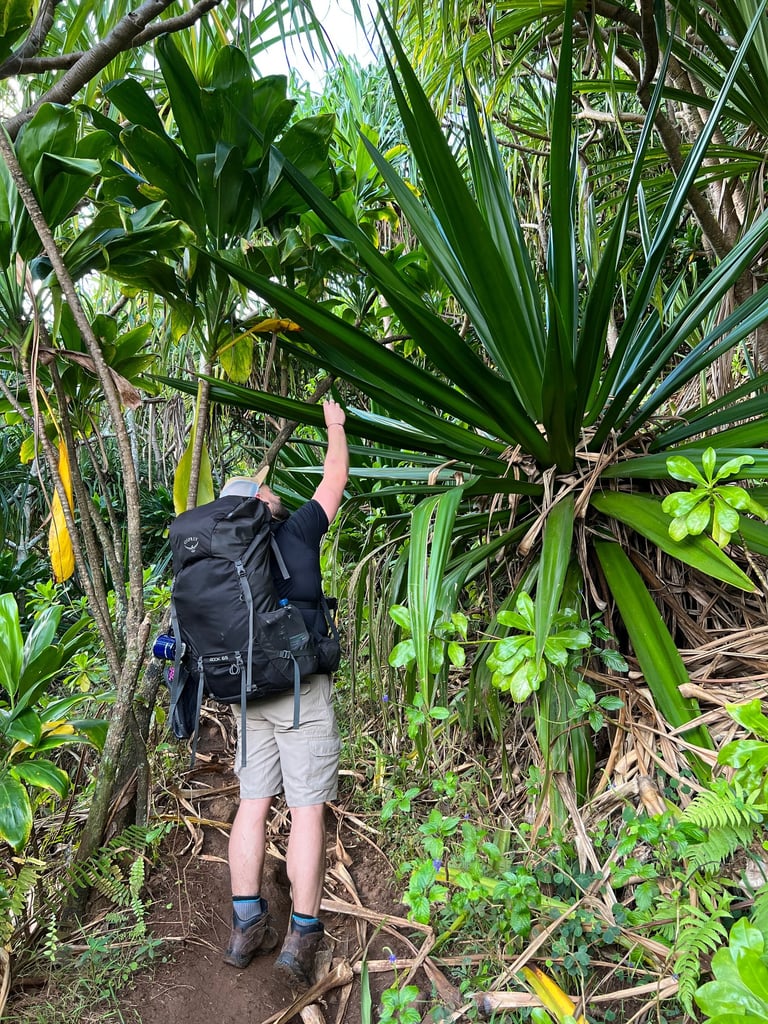
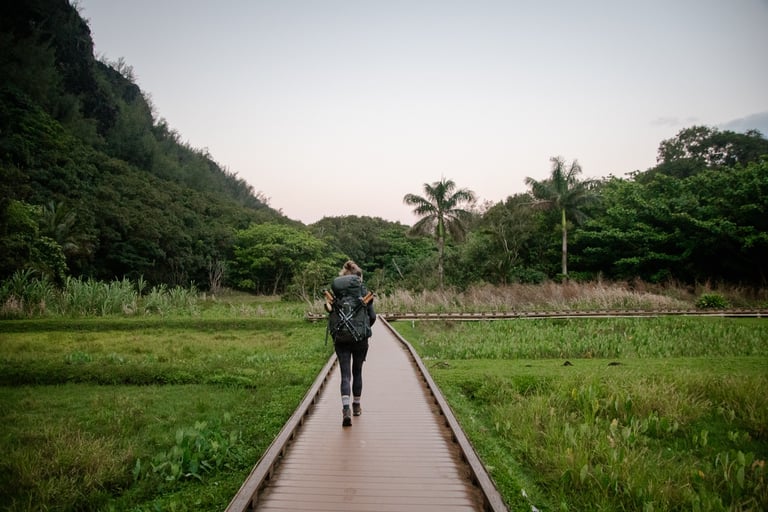
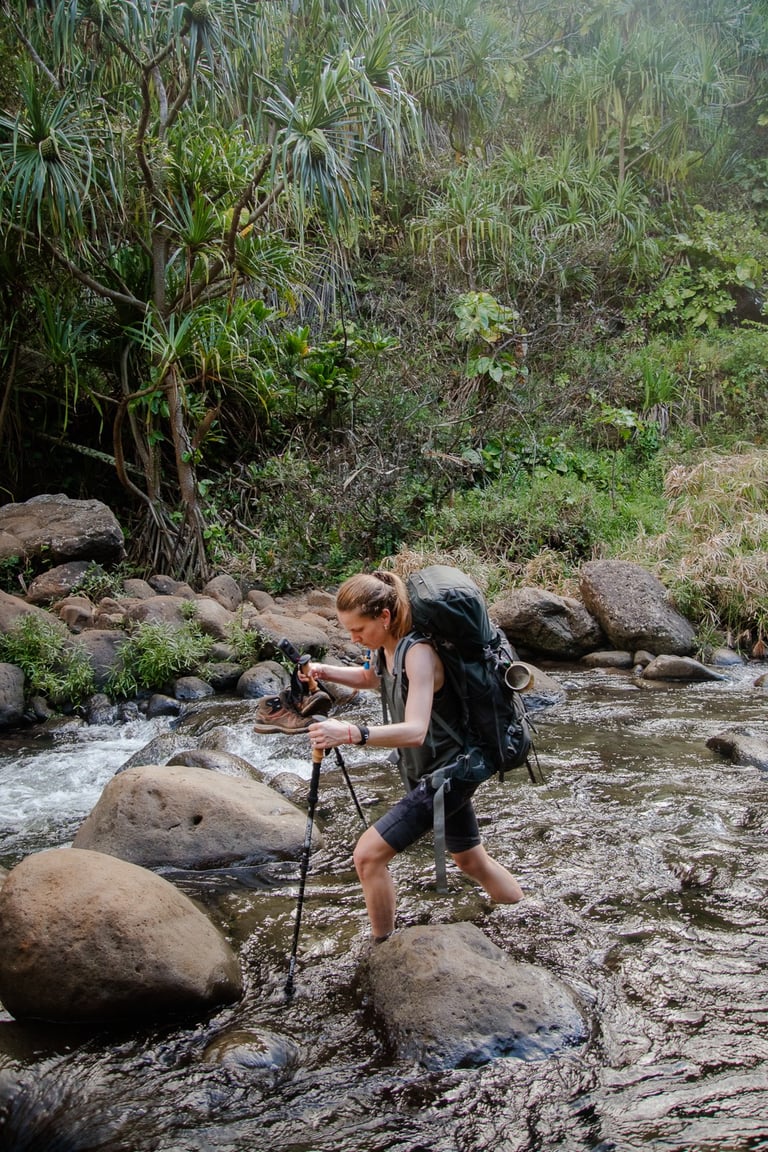




The Trail Unfolds
At around 10am we reached Hanakoa campsite (at around 9km) and the short detour to Hanakoa Falls—a beautiful spot that we left for our way back.
The infamous Crawlers Ledge came next—narrow rocky paths with sheer drops to the ocean. It's not as terrifying as it looks in photos, but in rain? That's a different story. A fall here would be catastrophic. Fortunately, we crossed it dry. Beyond the ledge, the danger actually increases: the terrain remains sheer but switches to dirt and loose rock, which becomes treacherous when wet. Microspikes and poles can help, but timing this section when it’s dry is the safest option.
After another 2 km of ups and downs, you’ll crest the last ridge and finally lay eyes on the Kalalau Valley and the soaring walls of Kalepa Ridge. The final descent leads to Kalalau Beach at the 16 km mark—one of the most magical places on earth.
We arrived at Kalalau beach at around 2pm so we had plenty of time to explore the area and soak it all in. We set up camp, explored caves, spotted crabs and birds. You also might see some turtles if you are lucky. We rinsed off under the Ho‘ole‘a Falls, and just exhaled. The sunset that night—orange, pink, and fiery purple—was one of the most soul-soothing moments of our lives.
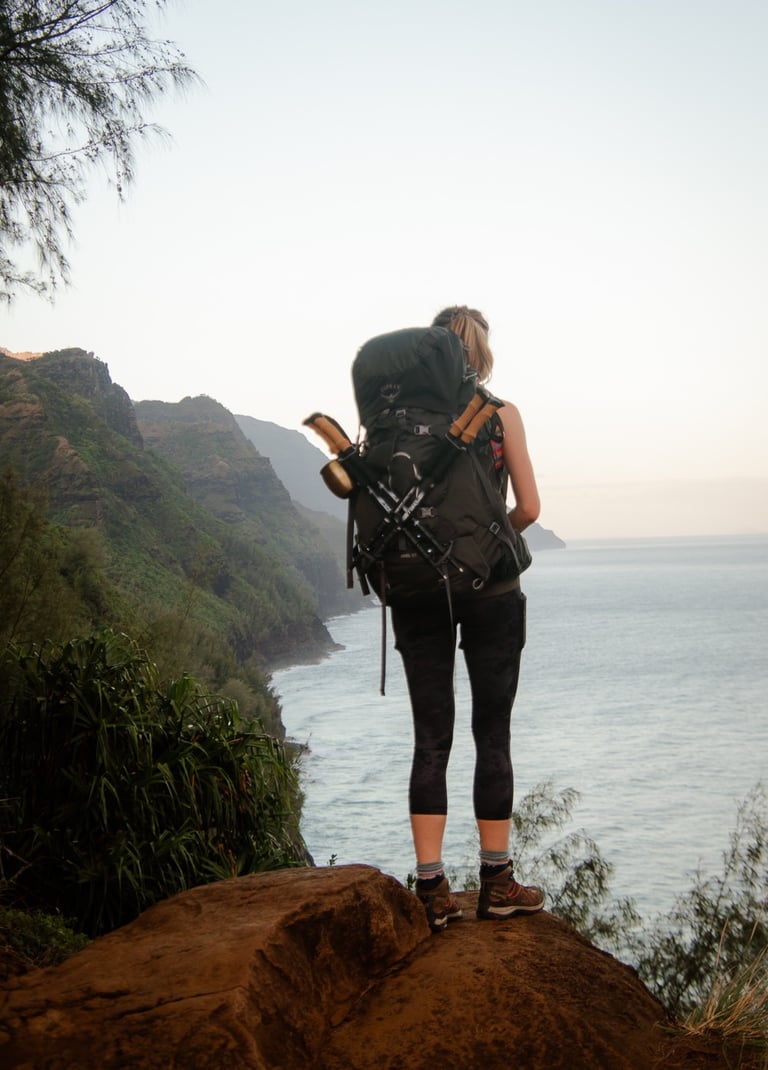

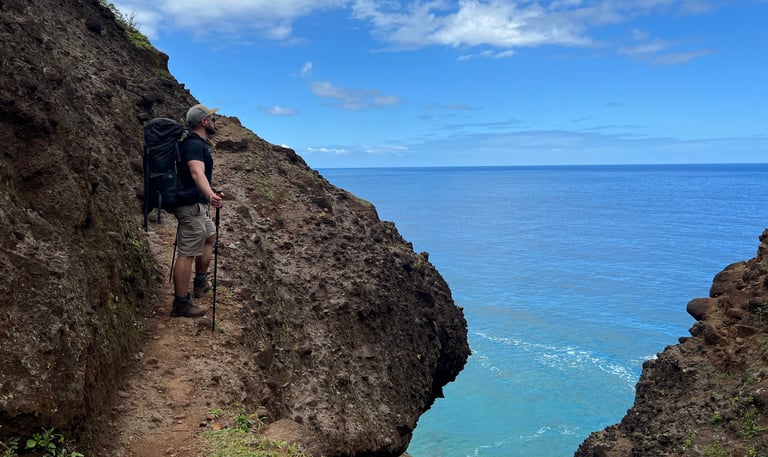

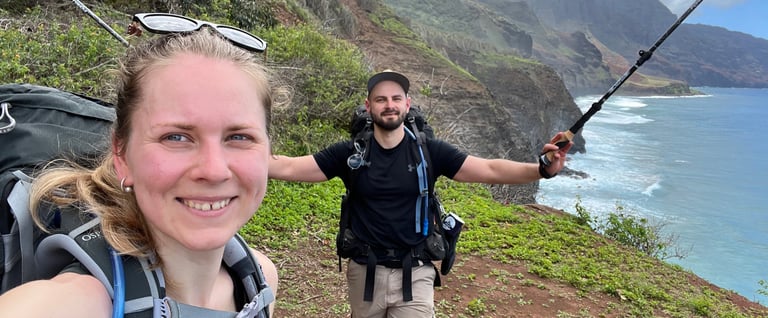

The Sacred Beach
The beach and its dramatic backdrop are nothing short of breathtaking. This is a sacred place, and it deserves reverence. We pitched our tents and explored, discovering a small cave toward Honopū Beach.
Swimming to Honopū is not advised—the currents are too dangerous. Even at Kalalau, the waves and rip currents demand caution. Stay close to shore, no matter how strong a swimmer you are.
Tour boats pass by but cannot land. Unfortunately, some private boats attempt to bring tourists ashore, disturbing the rare peace and solitude this place offers.
We rinsed off in Ho‘olea Falls—a refreshing, surreal moment. How often in life do you shower beneath a waterfall, far from civilization? Moments like these remind you how little you truly need. Simplicity here is freeing.
Cooking dinner, soaking in the sunset—everything slows down. The entire setting feels otherworldly. The Nā Pali Coast is easily one of the top three most breathtaking views of our lives.
Preparing for the Night
We packed light: no warm sleeping bags needed since nights stay tropical. A tent and netting, however, are essential for rain, bugs, and even wandering goats. We woke with the sunrise, the tent heating up under the morning light. Setting camp under trees provided both shade and wind protection.
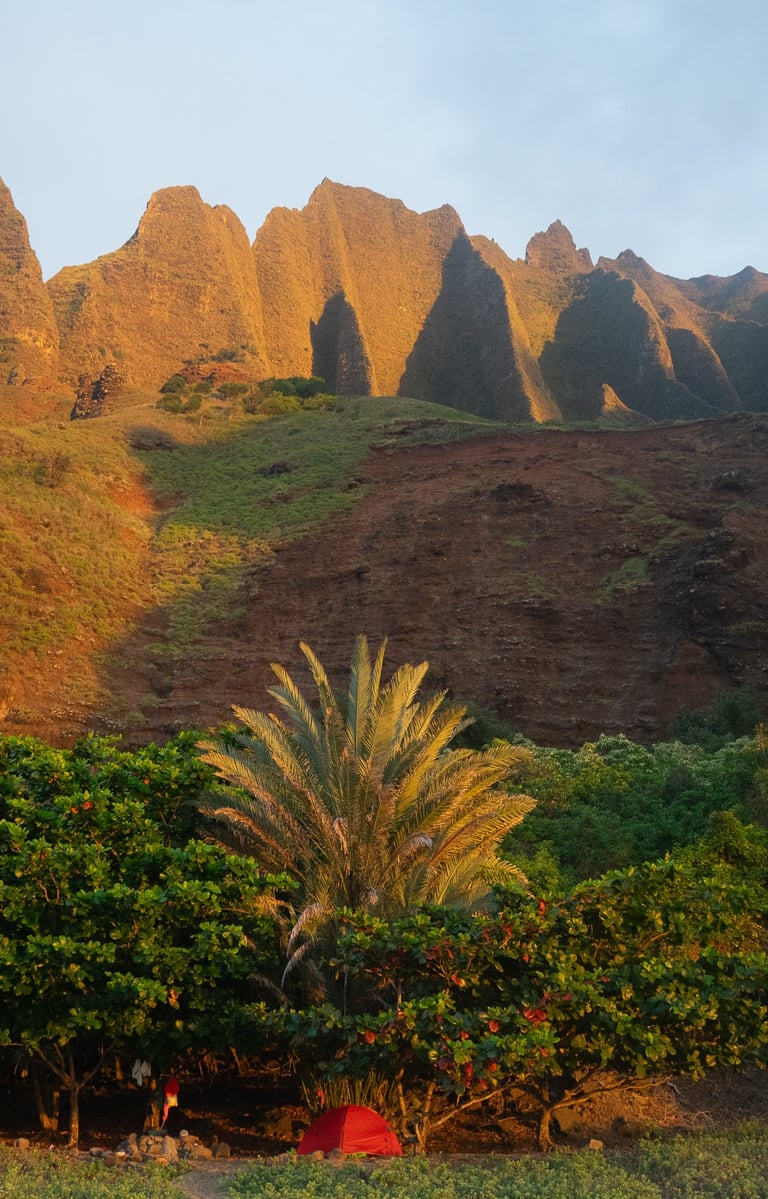

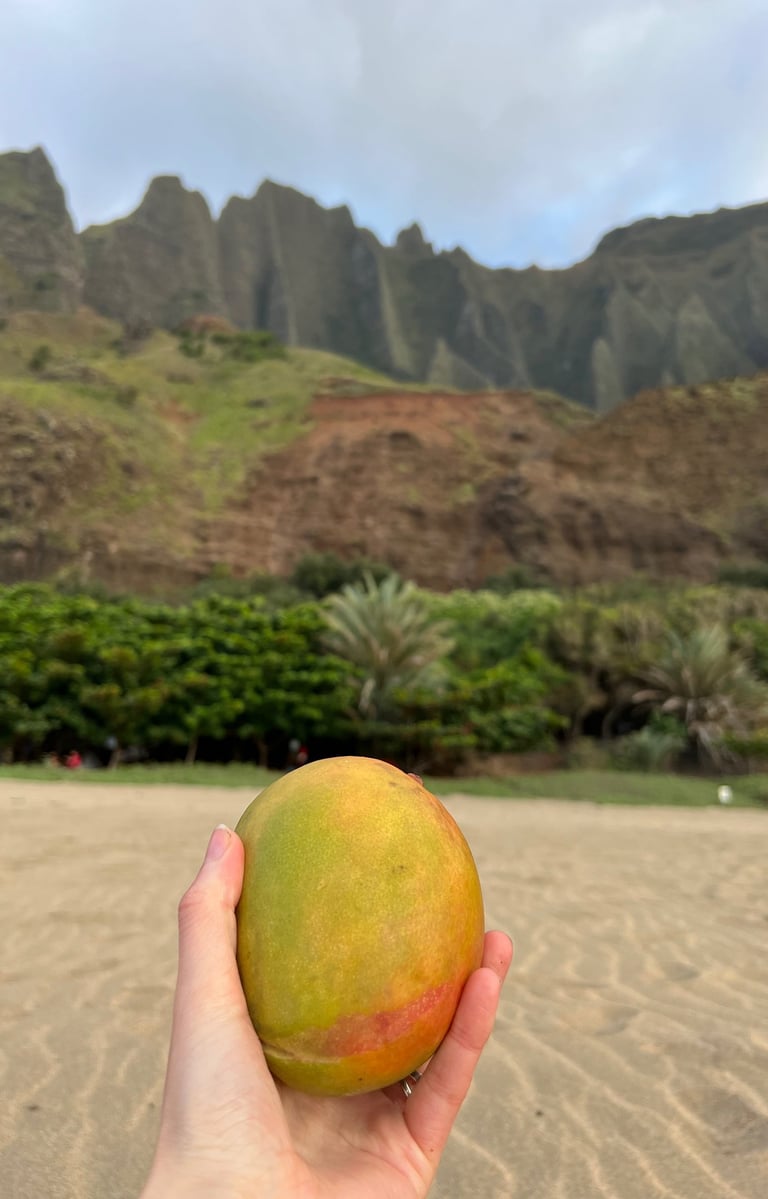

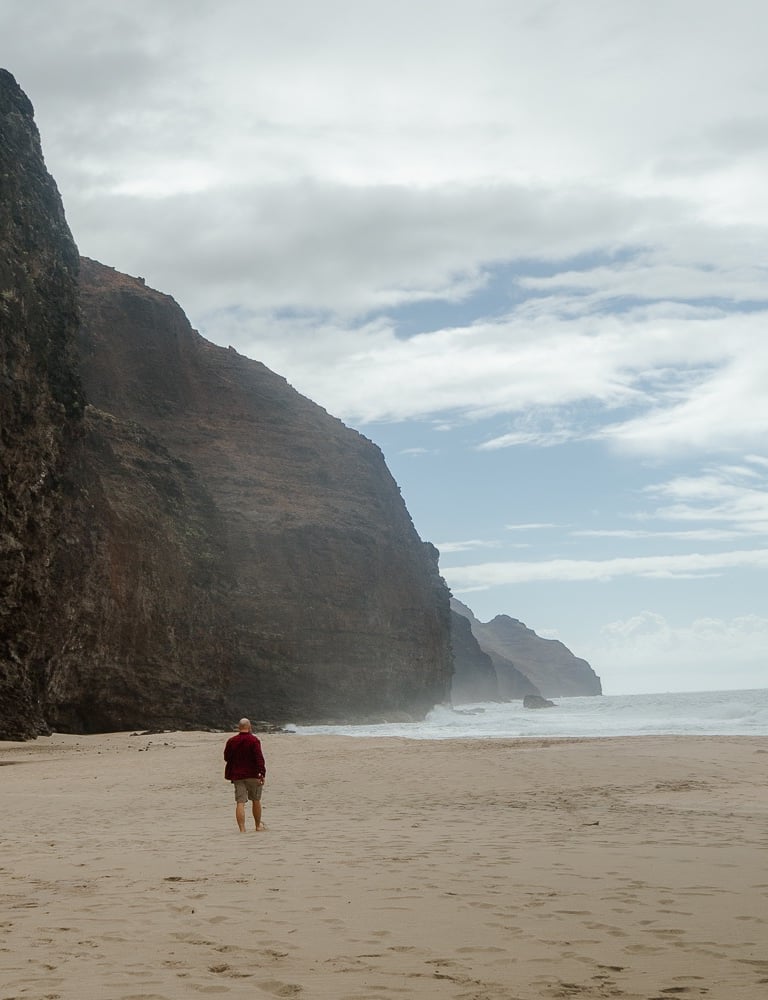

The Way Back: A Lesson in Respect for Nature
Forecasts warned of worsening weather, but we had no choice. We started back under heavy skies, crossing the exposed sections before the rain hit. After a stop at Hanakoa Falls, we lost precious time.
And then it hit. Tropical rain. The kind that soaks you to the bone no matter what you wear. Waterproof jackets quickly failed. This the moment when it’s better to let clothes get wet and keep dry layers sealed in your pack.
By the time we reached Hanakāpī‘ai Stream, it was a monster. The calm creek from the day before had transformed into a roaring brown river. Uncrossable. Flash floods are common here and can strand hikers for days. We had a ride scheduled and families expecting us out—no cell service, no way to communicate.
We waited, but the water didn’t calm. Eventually, a trail runner passed from the opposite direction, saying he’d swum around the crossing in the ocean. Unthinkable for us, loaded with packs...All of a sudden, another stranded couple arrived, and without supplies, they were even worse off.
We decided to try it together. We went down to the beach and entered the water where the stream was entering the ocean. It was the most terrifying 40 minutes of our lives trying to navigate it through holding onto the rocks in the stream —water up to our chests, a raging river on one side, crashing waves on the other. At one point, the woman from the other couple slipped, vanished underwater and we all held our breaths for a couple seconds. By sheer luck she surfaced downstream unhurt.
Somehow, we made it across. It was reckless—plain and simple—and we were lucky to survive. That river crossing was the dumbest, riskiest thing we’ve ever done. And we’ll never forget it. We are not writing about it to brag, rather the opposite.
The final kilometers were walked in silence, reflecting on how close we came to a disaster. We met our drive an hour later than we were supposed to, but he knew immediately what was the reason. He was worried but happy that we are safe, and ooh boy, so were we. We phoned home, quietly grateful.
Kalalau: Raw. Sacred. Unforgettable.
The Kalalau Trail is unforgettable—but it demands respect. Every year, hikers die from falls, flash floods, drowning, and rip currents. Every year, people drown here or get swept away. It's not something to take lightly.
Our Top Recommendations for Kalalau Trail:
Create an account at the Hawaii State parks website before the permit pool opens.
Get your permit early—90 days ahead on the official site. No permit = $500 fine + no access beyond Hanakāpī‘ai.
Pack light but smart: waterproof everything, bring both if you can - solid hiking shoes and sandals, water filter, and minimal but protective gear.
Time your hike to avoid storms. Watch weather reports closely—especially for rain in the mountains.
Bring a satellite communicator (Garmin in reach or iPhone 14 and later with Emergency SOS).
Never risk a flooded crossing - make sure to pack extra food in case you get stranded.
Embrace simplicity of the island. You don’t need much. The less you carry, the more you see.
The Nā Pali Coast is more than just a hike. It’s really is a sacred place —to raw beauty, to the edges of fear, and to the simple realization that we need very little to feel truly alive. At Kalalau, you learn quickly: nature is in charge. And that’s exactly why it’s so magical.
Useful Links
Kalalau permit reservation website
General information about permits
Official State of Hawaii website - create your account prior to buying the permit
Parking spot reservation - after you have secured a permit
Kalalau trail facebook group
Explore
Inspiring mindful adventures in nature sustainably.
Join the wandering Community
© 2024. All rights reserved.
by @wanderingintwo
